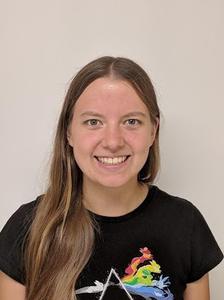ESP Biography
ANNINA SARTOR, Graduate student researching cryogenic microscopy
|
Major: Chemistry College/Employer: Stanford Year of Graduation: 2021 |

|
Brief Biographical Sketch:
I'm in the fifth year of my PhD program in the Chemistry department, developing methods to use fluorescence microscopes to see single molecules in cells frozen at cryogenic temperatures with liquid nitrogen. Past Classes(Clicking a class title will bring you to the course's section of the corresponding course catalog)C7388: A single molecule: the smallest thing you can see in Splash Fall 2019 (Nov. 16 - 17, 2019)
Have you ever wondered what a molecule looks like? In this course, we’ll learn how we can use an optical microscope to see individual molecules. To understand how this works, we’ll learn about lenses and look at what all the parts of a microscope do. Then, we’ll explore the concept of diffraction and how it affects what we see in the microscope. We’ll see how some molecules radiate light by a process called fluorescence, and how we can use that light to see a single molecule even though it’s surrounded by millions of other molecules. Finally, we’ll learn about a Nobel Prize-winning technique called super-resolution imaging, which combines all these big ideas to look at biological structures like DNA, mitochondria, and the cell membrane one molecule at a time.
C7023: A single molecule: the smallest thing you can see in Splash Spring 2019 (May. 04 - 05, 2019)
Have you ever wondered what a molecule looks like? In this course, we’ll learn how we can use an optical microscope to see individual molecules. To understand how this works, we’ll learn about lenses and look at what all the parts of a microscope do. Then, we’ll explore the concept of diffraction and how it affects what we see in the microscope. We’ll see how some molecules radiate light by a process called fluorescence, and how we can use that light to see a single molecule even though it’s surrounded by millions of other molecules. Finally, we’ll learn about a Nobel Prize-winning technique called super-resolution imaging, which combines all these big ideas to look at biological structures like DNA, mitochondria, and the cell membrane one molecule at a time.
C6770: Optics IRL in Splash Fall 2018 (Dec. 01 - 02, 2018)
We will teach about different properties of light and demonstrate how they result in different phenomena in our world.
C6876: A single molecule: the smallest thing you can see in Splash Fall 2018 (Dec. 01 - 02, 2018)
Have you ever wondered what a molecule looks like? In this course, we’ll learn how we can use an optical microscope to see individual molecules. To understand how this works, we’ll learn about lenses and look at what all the parts of a microscope do. Then, we’ll explore the concept of diffraction and how it affects what we see in the microscope. We’ll see how some molecules radiate light by a process called fluorescence, and how we can use that light to see a single molecule even though it’s surrounded by millions of other molecules. Finally, we’ll learn about a Nobel Prize-winning technique called super-resolution imaging, which combines all these big ideas to look at biological structures like DNA, mitochondria, and the cell membrane one molecule at a time.
C5498: Fun with Chemistry in Splash Spring 2017 (Apr. 22 - 23, 2017)
Chemistry is exciting and it happens all around us every day. In this class we will talk about the states of matter, a little about polymers (like plastics), and really anything else that gives us a chance to do cool demos for you all! You may get a chance to make a souvenir to take home, too. You'll just have to come and find out!
P4802: Fun with Chemistry! in Splash Spring 2016 (Apr. 09 - 10, 2016)
Chemistry is exciting and it happens all around us every day. In this class we will talk about the states of matter, a little about polymers (like plastics), and really anything else that gives us a chance to do cool demos for you all! You may get a chance to make a souvenir to take home, too. You'll just have to come and find out!
|
|
